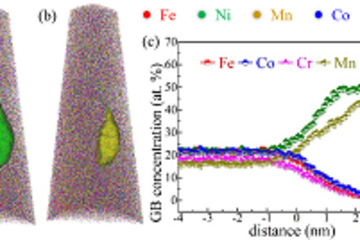All genres
841.
Journal Article
Yielding of polyethylene through propagation of chain twist defects: Temperature, stem length and strain-rate dependence. Polymer 47 (5), pp. 1696 - 1703 (2006)
842.
Journal Article
Strong and Ductile Martensitic Steels for Automotive Applications. Steel Research International 77, 9-10, pp. 704 - 711 (2006)
843.
Journal Article
Characterization of the Microstructure and Texture of Nanostructured Electrodeposited NiCo by use of Electron Backscatter Diffraction (EBSD). Acta Materialia 54, pp. 2451 - 2462 (2006)
844.
Journal Article
A dislocation density based constitutive model for crystal plasticity FEM including geometrically necessary dislocations. Acta Materialia 54, pp. 2169 - 2179 (2006)
845.
Journal Article
Studying the effect of grain boundaries in dislocation density based crystal plasticity finite element simulations. International Journal of Solids and Structures 43, pp. 7287 - 7303 (2006)
846.
Journal Article
On the origin of size effects in small-strain elasticity of solid polymers. International Journal of Solids and Structures 44, pp. 1582 - 1592 (2006)
847.
Journal Article
Microstructure and crystallographic texture of the chitin-protein network in the biological composite material of the exoskeleton of the lobster Homarus americanus. Materials Science and Engineering A 421, pp. 143 - 153 (2006)
848.
Journal Article
Experimental investigation of the elastic-plastic deformation of mineralized lobster cuticle by digital image correlation. Journal of Structural Biology 155, pp. 409 - 425 (2006)
849.
Journal Article
Recrystallization of the ODS superalloy PM-1000. Materials Science and Engineering A 430, pp. 172 - 178 (2006)
850.
Journal Article
Size effects on the magnetic properties of Cu-Nb nanofilamentary wires processed by severe plastic deformation. Superconducting Science and Technology 19, pp. 1233 - 1239 (2006)
851.
Journal Article
Overview of processing, microstructure and mechanical properties of ultrafine grained bcc steels. Materials Science and Engineering A 441, pp. 1 - 17 (2006)
852.
Journal Article
Simulation of the deformation texture of a 17%Cr ferritic stainless steel using the texture component crystal plasticity FE method considering texture gradients. Scripta Materialia 54, pp. 1537 - 1542 (2006)
853.
Journal Article
Scaling effects in microscale fluid flows at rough solid surfaces. Modeling and Simulation in Materials Science and Engineering 14, pp. 857 - 873 (2006)
854.
Journal Article
Optimisation of precipitation for controlling recrystallisation of wrought Fe3Al based alloys. Intermetallics 13 (12), pp. 1296 - 1303 (2005)
855.
Journal Article
Effect of hot and cold deformation on the recrystallization texture of continuous cast AA 5052 aluminum alloy. Scripta Materialia 53 (11), pp. 1273 - 1277 (2005)
856.
Journal Article
Influence of Mn Content on the Microstructure and Mechanical Properties of Ultrafine Grained C–Mn Steels. ISIJ International 45/11, pp. 1721 - 1726 (2005)
857.
Journal Article
EBSD study of grain subdivision of a Goss grain in coarse-grained cold-rolled niobium. Scripta Materialia 53 (2), pp. 207 - 212 (2005)
858.
Journal Article
Improvement of the work hardening rate of ultrafine grained steels through second phase particles. Scripta Materialia 52/11, pp. 1075 - 1080 (2005)
859.
Journal Article
Microstructure and crystallographic texture of an ultrafine grained C–Mn steel and their evolution during warm deformation and annealing. Acta Materialia 53 (3), pp. 845 - 858 (2005)
860.
Journal Article
Characterization of Nanostructured Electrodeposited NiCo Samples by use of Electron Backscatter Diffraction (EBSD). Mater. Res. Soc. Sympos. Proc. 880E, BB1.3. (2005)











